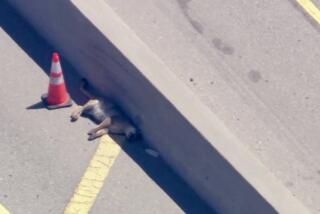Freeway Car-Pool Lane Won’t Harm Environment, Study Says
Caltrans has concluded in a new report that a $44.6-million project to add an exclusive car-pool lane on the San Diego Freeway between the Harbor and Marina freeways will not have a significant impact on the environment.
The 30-page environmental assessment does not examine the potential impact on motorists while the project is under way, but state transportation officials concede that putting a car-pool lane in the middle of one of the nation’s busiest freeways poses a major challenge.
“It is not without difficulty,” said Dave Roper, Caltrans deputy district director for operations. “We’re going to have to come up with some way to keep the traffic moving.”
The work will have to be done at night and on weekends to minimize potential traffic disruptions, Roper said.
Project to Begin in 1990
The project calls for squeezing the car-pool lane into the existing 405 Freeway by all but eliminating the shoulder in the median and narrowing the present traffic lanes to less than the standard for interstate highways.
The 13-mile-long project is scheduled to begin in 1990 and be completed in 1994, if state and federal funding is available. Actual construction--most of it in reconfiguring existing lanes--will be done in stages and take two years. The delay in completing the project stems from a shortage of state gas-tax revenues, which cannot pay for all the road projects now scheduled, state officials said.
Roper said that before the work begins, Caltrans will develop a separate traffic management plan that may include restriping adjacent surface streets, installing automated traffic signals, and restricting parking in an effort to relieve freeway congestion.
“We will design and carry out the job with the idea that during the heavy traffic hours we will not be closing lanes,” he said. “The movement of traffic is of prime importance to us.”
The environmental assessment prepared by the California Department of Transportation indicates that the car-pool lane by itself will not have a significant environmental impact.
There will be no significant change in air quality, water quality, noise levels or energy use when the project is completed, and no effect is expected on businesses, residences or schools.
Several Cities Involved
The route passes through parts of the city of Los Angeles, Culver City, Inglewood, Hawthorne, Redondo Beach, Lawndale, Torrance and unincorporated parts of Los Angeles County.
The environmental assessment notes that the San Diego Freeway from the Marina Freeway to the Harbor Freeway suffers from heavy congestion.
Interstate 405 at the Marina Freeway, north of Los Angeles International Airport, is one of the most heavily traveled freeways in the country, carrying an average of 224,000 vehicles a day in 1987. At the interchange with the Harbor Freeway, the San Diego Freeway carried an average of 191,000 vehicles a day in 1987.
“The congestion is not isolated to the peak periods alone, but is recurrent for most hours of the day during weekdays and is present for significant periods of the day on weekends,” the report said.
Based on projected growth in population, the number of housing units and jobs in West Los Angeles, the South Bay and Long Beach areas, Caltrans expects the freeway--without any improvements--will be operating at stop-and-go conditions at least three hours a day in the near future.
Caltrans said 21% of the vehicles using the freeway are carrying two or more occupants, but they share the same traffic lanes with other motorists.
3,500 People Per Hour
The car-pool lane would allow the freeway to carry an additional 3,500 people per hour by giving those vehicles an exclusive lane, according to the environmental document. Caltrans projections for 2010 show that up to 308,000 vehicles daily will be using the San Diego Freeway at the Marina Freeway.
“You are adding capacity to that freeway and it desperately needs capacity,” Roper said. “It provides an incentive to shift into ride-sharing.” There is no discussion in the assessment of the potential impact on traffic while the work is being done. But Roper said that issue “will receive a great deal of special attention” when the traffic management plan is prepared.
The car-pool lane is part of an ambitious plan to build a so-called high-occupancy vehicle lane along the 405 from the Marina Freeway in Los Angeles County to the junction of the San Diego and Santa Ana freeways in Orange County, a distance of 50 miles.
The project is being built in stages. A five-mile portion of the car-pool lane in Orange County opened to traffic early this year.
More to Read
Sign up for Essential California
The most important California stories and recommendations in your inbox every morning.
You may occasionally receive promotional content from the Los Angeles Times.









